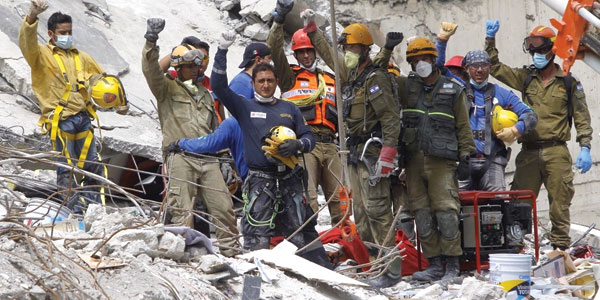
MEXICO CITY — My city is broken, but my people are not.
After the recent 7.1 magnitude earthquake here, I returned to the streets I knew so well in my youth, and I hardly recognized them. Dozens of buildings in the city have collapsed; the rubble is now obscured by a canopy of laborers in blue, red or white helmets. As these rescuers search for victims, some stop and raise their fists, a request for silence. If they think someone might alive under the debris, they listen carefully for any sound. After a few moments they lower their arms, and begin to search again.
Nearby hundreds of people whose loved ones are missing wait behind police tape. It’s 2 a.m., and still they remain. They won’t leave until they know whether their mother, brother or child is dead or alive.
A woman in the crowd named Conchita is worried and angry. Her daughter Karen, an accountant, was working in the fourth floor of a building that crumbled in Mexico City’s Roma neighborhood, and she hasn’t received any news about her. As we converse, Conchita talks about her daughter in the present tense. She takes me to an area marked off by police tape and, almost screaming, laments the fact that rescue workers stopped removing rubble there a couple of hours ago, that her daughter’s life depends on them working around the clock. Finally, I hug her and she hugs me back, in tears.
Brian’s house was destroyed by the earthquake. He tells me he and his family are staying in a car for the time being, but he has spent the day helping at several rescue sites. He’s been awake for more than 24 hours, and he’s still full of energy. “I can’t sleep as long as there are people who need help,” he tells me.
Brian’s attitude and drive represent the best of Mexico. Amid this crisis, we have shown an outstanding capacity to work together and respond, and I’m sure this spirit will endure. In July 2018, there will be a presidential election, and this earthquake will still be fresh on voters’ minds.
This will likely be detrimental to President Enrique Peña Nieto’s administration. The false information about “Frida Sofia” — a 12-year-old girl said to be buried in the rubble of a collapsed school building, and who was presumed to be on the verge of rescue for hours — and the spreading of those inaccuracies by officials cost the government credibility during a critical time. In the immediate aftermath of the earthquake, senior officers from the Mexican navy, and even the minister of education, fed this false narrative in an effort to paint the administration as being efficient and compassionate amid a national tragedy.
Frida Sofia never even existed; her story was just more evidence that Mexicans cannot trust the information coming from the Peña Nieto administration. Officials’ tales of a capable and forthcoming administration in the aftermath of the earthquake were as impossible to believe as the stories about the first lady’s purchase of a home from a government contractor, or the failed efforts to locate 43 missing college students from Ayotzinapa.
I was thousands of miles away, in Mexicali, when I heard the news about the earthquake. I turned on the TV and felt a sense of déjà vu. Just as I had when a quake struck Mexico City on September 19, 1985, I saw how people immediately rushed out to rescue their neighbors. The army, Red Cross and the “topos” — those amazing teams who dive into the debris looking for signs of life — would arrive later. The people were first to respond.
Lately I’ve come across many examples of Mexican ingenuity and the nation’s can-do spirit. In Mexicali, I met college students from the Centro de Enseñanza Técnica Y Superior working to make their school one of the top 10 universities in the world (and I am sure they will manage to do it). And every time President Trump insults Mexican immigrants, I remember a neurosurgeon from Baja California, Alfredo Quiñones, who has saved so many lives at the Mayo Clinic and other of the best hospitals in the U.S. And let’s not forget the thousands of Mexican workers cleaning and rebuilding Texas and Florida after hurricanes Harvey and Irma.
Our hearts were crushed by the earthquake, and recovery will take years. But almost every time I’ve spoken with someone in Mexico, I’ve gotten a sense of a renewed optimism in the country. On the streets where I grew up, I noticed an energy verging on elation that I’ve never experienced before.
Even in the darkest times, we know we can move forward together. Just as the public mobilization after the 1985 earthquake gave rise to the country’s first real democratic elections in 2000, the 2017 earthquake has already demonstrated something very clear: We won’t give up.
(Jorge Ramos, an Emmy Award-winning journalist, is a news anchor on Univision. Originally from Mexico and now based in Florida, Ramos is the author of several best-selling books. His latest is “Take a Stand: Lessons From Rebels.” Email him at jorge.ramos@nytimes.com.)
_____________________________________________________________________________________
No Nos Vamos a Dejar
CIUDAD DE MÉXICO — Mi ciudad se quebró, pero mi gente no.
Regreso a algunas de las calles donde crecí y no las reconozco. Hay decenas de edificios caídos por el terremoto de 7,1 grados, pero los pedazos de cemento están cubiertos por una manta de cascos azules, rojos y blancos. Los trabajadores paran, levantan el puño y piden silencio. Es la señal de que, quizás, han encontrado a alguien con vida entre los escombros. Luego, bajan los brazos y esa manta multicolor se vuelve a mover buscando otra oportunidad.
No muy lejos, detrás de una cinta de la policía, esperan cientos de familiares. Dan las 2 de la mañana y todavía no se han ido. Ni se irán, hasta saber si su mamá, si su hermano, si su hijo está entre los muertos.
Conchita está angustiada y enojada. Su hija Karen, una contadora, trabajaba en el cuarto piso de un edificio que se derrumbó en la colonia Roma y no saben nada de ella. Conchita sigue hablando de su hija en presente, como si hacerlo en pasado fuera un mal augurio. Me lleva hasta el límite marcado por la policía con cinta amarilla y desafiante, casi gritando, se queja de que los rescatistas dejaron de remover piedras hace un par de horas y que la vida de su hija depende de que no paren. Al final la abrazo y ella acepta el abrazo entre lágrimas.
Brian no tiene casa. Se le cayó con el temblor. Él y su familia ahora viven en un coche, pero Brian ha pasado el día ayudando en varios rescates. Lleva más de 24 horas sin dormir, y aún está lleno de energía. “No puedo dormir mientras haya gente a quien se pueda ayudar,” me dijo.
Su conducta refleja lo mejor de México. Además de una maravillosa solidaridad, los mexicanos han demostrado una extraordinaria capacidad de respuesta tras el sismo, y estoy seguro de que esto se va a extender a muchas otras cosas. Los mexicanos elegiremos presidente el próximo primero de julio de 2018, y este terremoto va a estar muy fresco en la memoria de los votantes.
La mentira sobre Frida Sofía — esa supuesta niña de 12 años que estaba a punto de ser rescatada en una escuela que se cayó le quitó la poca credibilidad que le quedaba al gobierno en un momento crucial. Altos funcionarios de la Marina y hasta el propio Secretario de Educación alimentaron durante las horas más críticas una falsa narrativa que convenía a un gobierno que se quería ver eficiente y compasivo ante la tragedia nacional.
Hay muchas, pero la primera conclusión es que periodistas y ciudadanos no podemos confiar en la información que viene del gobierno del presidente Enrique Peña Nieto. La actitud más saludable de cualquier reportero es desconfiar, siempre, de lo que dicen los gobiernos. Así como es imposible creer la versión oficial sobre la compra de la Casa Blanca y la desaparición de los 43 estudiantes de Ayotzinapa, también es muy difícil creer el cuento de un gobierno honesto y capaz tras el terremoto.
El temblor me sorprendió a miles de kilómetros, en Mexicali. Prendí la tele y fue un déjà vu. Otra vez, al igual que en el terremoto del 19 de septiembre de 1985, vi como los vecinos fueron los primeros en ayudar a otros vecinos. El Ejército, la Cruz Roja y los topos — esos increíbles seres que entran y salen de los hoyos buscando vida — aparecerían más tarde. Pero los primeros rescatistas fueron ciudadanos.
Últimamente me he encontrado con grandes ejemplos del ingenio mexicano. En Mexicali conocí a muchos estudiantes de la Universidad CETYS, cuyo objetivo a mediano plazo es ubicar a su centro de estudios entre los 10 mejores del mundo, y estoy seguro que lo van a lograr. Ante cada insulto de Donald Trump contra los inmigrantes mexicanos, suelo pensar en Alfredo Quiñones, un neurocirujano bajacaliforniano que ha salvado miles de vidas en la Clínica Mayo y en los mejores hospitales de Estados Unidos. Además, son manos mexicanas las de miles de jardineros y trabajadores que están limpiando y levantando a Texas y la Florida tras el paso de los huracanes Harvey e Irma.
El terremoto, es cierto, nos tiene a todos con el corazón apachurrado. Recuperarse de este brutal golpe va a tomar años. Sin embargo, en casi todas mis pláticas he encontrado un sorprendente y renovado optimismo entre los mexicanos. En las calles donde crecí de joven hay una energía, casi euforia, que nunca antes vi.
Ante la adversidad ha habido mil respuestas alentadoras del ingenio mexicano. Incluso en los momentos más difíciles — como ocurre después de un sismo — juntos sabremos salir adelante. Así como la movilización ciudadana tras el sismo de 1985 fue el preludio de las primeras elecciones democráticas en México en el año 2000, el terremoto de este 2017 ha dejado ya una clara lección: No nos vamos a dejar.
(Jorge Ramos, periodista ganador del Emmy, es el principal director de noticias de Univision Network. Ramos, nacido en México, es autor de nueve libros de grandes ventas, el más reciente de los cuales es “A Country for All: An Immigrant Manifesto.”)










